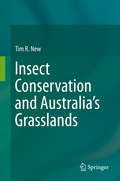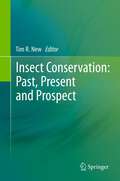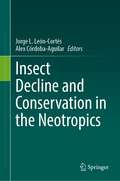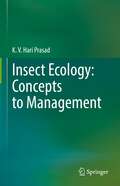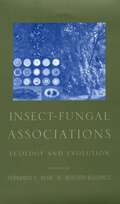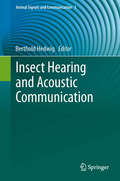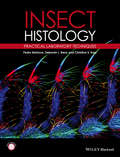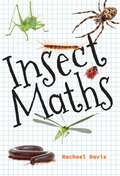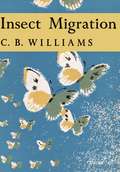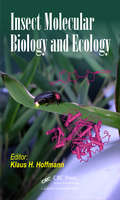- Table View
- List View
Insect Conservation and Australia’s Grasslands
by Tim R. NewAustralia’s varied grasslands have suffered massive losses and changes since European settlement, and those changes continue under increasingly intensive human pressures for development and agricultural production. The values of native grasslands for conservation of endemic native biodiversity, both flora and fauna, have led to strong interests in the protection of remaining fragments, especially near urban centres, and documentation of the insects and other inhabitants of grasslands spanning tropical to cool temperate parts of the country. Attention to conservation of grassland insects in Australia is relatively recent, but it is increasingly apparent that grasslands harbour many localised and ecologically specialised endemic species. Their conservation necessarily advances from very incomplete documentation, and draws heavily on lessons from the far better-documented grasslands elsewhere, most notably in the northern hemisphere, and undertaken over far longer periods. From those cases, and the extensive background to grassland management to harmonise conservation with production and amenity values through honing use of processes such as grazing, mowing and fire, the needs and priorities for Australia can become clearer, together with needs for grassland restoration at a variety of scales. This book is a broad overview of conservation needs of grassland insects in Australia, drawing on the background provided elsewhere in the world on the responses to disturbances, and the ecological importance, of some key insect groups (notably Orthoptera, Hemiptera and Lepidoptera) to suggest how insect conservation in native, pastoral and urban grasslands may be advanced. The substantial references given for each chapter facilitate entry for non-entomologist grassland managers and stewards to appreciate the diversity and importance of Australia’s grassland insects, their vulnerabilities to changes, and the possibilities for conserving them and the wider ecological roles in which they participate.
Insect conservation and Australia’s Inland Waters
by Tim R. NewThe first broad overview of conservation needs of Australia’s largely endemic freshwater insects, drawing on examples and information from many parts of the world to illustrate and develop needs and practical prospects for conservation in inland water environments. The wide variety of those environments in Australia and their diverse insect inhabitants – many of them highly localised and ecologically specialised and vulnerable - and threats to them is illustrated. Case histories demonstrate the different aspects of practical conservation management that may be possible in different contexts, and numerous references facilitate understanding by non-specialist readers and non-entomologist conservation managers and practitioners.
Insect Conservation and Urban Environments
by Tim R. NewIncludes chapters on assessing changes among assemblages and in individual species, the variety of general threats (notably habitat changes and impacts of alien species) and more particularly urban threats. The first global overview and synthesis of the impacts of urbanisation on insects and their relatives and the needs and theoretical and practical background to conserving them in urban environments. Insect dependence on open spaces in built-up areas suggests a wide range of management options for conservation, from individual site (including novel habitats such as green roofs) to landscape-level connectivity. These measures, all discussed with specific examples, involve all sectors of humanity, from government agencies to individual householders and ‘citizen scientist’ groups. Each chapter includes pertinent and recent.
Insect Conservation: Past, Present and Prospects
by Tim R. NewThe history of interest and practice in insect conservation is summarised and traced through contributions from many of the leaders in the discipline, to provide the first broad global account of how insects have become incorporated into considerations of conservation. The essays collectively cover the genesis and development of insect conservation, emphasising its strong foundation within the northern temperate regions and the contrasts with much of the rest of the world. Major present-day scenarios are discussed, together with possible developments and priorities in insect conservation for the future.
The Insect Crisis: The Fall of the Tiny Empires that Run the World
by Oliver MilmanWhen is the last time you were stung by a wasp? Or were followed by a cloud of midges? Or saw a butterfly? All these normal occurrences are becoming much rarer. A groundswell of research suggests insect numbers are in serious decline all over the world - in some places by over 90%.The Insect Crisis explores this hidden emergency, arguing that its consequences could even rival climate change. We rely on insect pollination for the bulk of our agriculture, they are a prime food source for birds and fish, and they are a key strut holding up life on Earth, especially our own. In a compelling and entertaining investigation spanning the globe, Milman speaks to the scientists and entomologists studying this catastrophe and asks why these extraordinary creatures are disappearing. Part warning, part celebration of the incredible variety of insects, this book highlights why we need to wake up to this impending environmental disaster.
Insect Decline and Conservation in the Neotropics
by Jorge L. León-Cortés Alex Córdoba-AguilarThis book provides for the first time an integrative analysis of the major drivers of decline and threats of insects and related arthropods in the Neotropical region. Thus, it is an urgent first step towards filling an information gap in this region. It identifies the main causes of decline, provides and discusses examples from the better-studied insect faunas to develop and advance principles and practical conservation management for the rich Neotropical insect faunas. The book is aimed at students, naturalists, environmental managers, and others who have training in entomology/insect ecology and can apply the results of surveys of key insect faunas to assess their vulnerability to environmental change and establish guidelines for their conservation.
Insect Diets: Science and Technology, Second Edition
by Allen Carson CohenDr. Allen Carson Cohen's new edition of Insect Diets: Science and Technology continues to provide a current, integrated review of the field of insect diets. It reaffirms and expands upon the belief that the science of diet development and the technology of diet application in rearing programs require formal foundations and guidelines. Cohen argues
Insect Diversity, Declines and Conservation in Australia (Fascinating Life Sciences)
by Tim R. NewProblems of insect enumeration and assessment of needs are addressed in the contexts of rapid and substantial losses and changes to all key Australian terrestrial and freshwater environments and promoting awarenesss of the importance of insects. Further definition of the insect fauna and its peculiarities can aid threat alleviation and practical management to protect and conserve this unique and largely endemic biodiversity. Written for the many environmental managers and naturalists who are not primarily entomologists, the ten chapters expand from considerations of insect decline and diversity to the unique features of the Australian fauna and its characterisation. Cases and examples from throughout the world illustrate the major needs, approaches and priorities to sustaining a poorly known, diverse and ecologically varied insect heritage of global significance.
Insect Ecology: Concepts to Management
by K. V. PrasadThis book presents comprehensive information on various aspects of ecology with special reference to insects, to form a platform to design an ecologically sound insect pest management. Insects are the most dominant and diverse group of living organism on earth. Owing to their smaller size, smaller space and food requirements, more number of generation per unit time, insects serves as one of the best subject matter for studies on various ecological aspects such as chemical ecology, population dynamics, predator/parasitoid-prey interactions etc. The knowledge on various aspects of insect ecology helps in formulating an effective environmentally benign insect pest management. This book is of interest and use to the post graduate students and researchers working on various aspects of insect ecology with special emphasis on population dynamics, chemical ecology, tri tropic interactions, ecological engineering and Ecological Insect pest management.
Insect-Fungal Associations: Ecology and Evolution
by Fernando E. Vega Meredith BlackwellInsects and fungi have a shared history of association in common habitats where together they endure similar environmental conditions, but only recently have mycologists and entomologists recognized and had the techniques to study the intricacies of some of the associations. This new volume covers "seven wonders of the insect-fungus world" for which exciting new results have become available, often due to the use of new methods that include phylogenetic analysis and development of molecular markers. Eleven chapters of the volume are presented in two sections, "Fungi that act against insects" and "Fungi mutualistic with insects" that cover a number of major themes. Examples of necrotrophic parasites of insects are discussed, not only for biological control potential, but also as organisms with population structure and complex multipartite interactions; a beneficial role for symptomless endophytes in broad-leafed plants is proposed; biotrophic fungal parasites with reduced morphologies are placed among relatives using phylogenetic methods; complex methods of fungal spore dispersal include interactions with one or more arthropods; the farming behavior of New World attine ants is compared with that of humans and the Old World fungus-growing termites; certain mycophagous insects use fungi as a sole nutritional resource; and other insects obtain nutritional supplements from yeasts. Insects involved in fungal associations include--but are not limited to--members of the Coleoptera, Diptera, Homoptera, Hymenoptera, and Isoptera. The fungi involved in interactions with insects may be clustered taxonomically, as is the case for Ascomycetes in the Hypocreales (e.g., Beauveria, Metarhizium, Fusarium), ambrosia fungi in the genera ophiostoma and ceratocystis and their asexual relatives, Laboulbeniomycetes, Saccharomycetes, and the more basal Microsporidia. Other groups, however, have only occasional members (e.g., mushrooms cultivated by attine ants and termites) in such associations. The chapters included in this volume constitute a modern crash course in the study of insect-fungus associations.
Insect Hearing: Insects (Springer Handbook of Auditory Research #55)
by Gerald S. Pollack Andrew C. Mason Arthur N Popper Richard R. FayInsect Hearing provides a broadly based view of the functions, mechanisms, and evolution of hearing in insects. With a single exception, the chapters focus on problems of hearing and their solutions, rather than being focused on particular taxa. The exception, hearing in Drosophila, is justified because, due to its ever growing toolbox of genetic and optical techniques, Drosophila is rapidly becoming one of the most important model systems in neurobiology, including the neurobiology of hearing. Auditory systems, whether insectan or vertebrate, must perform a number of basic tasks: capturing mechanical stimuli and transducing these into neural activity, representing the timing and frequency of sound signals, distinguishing between behaviorally relevant signals and other sounds and localizing sound sources. Studying how these are accomplished in insects offers a valuable comparative view that helps to reveal general principles of auditory function.
Insect Hearing and Acoustic Communication (Animal Signals and Communication #1)
by Berthold HedwigThis volume provides a comprehensive selection of recent studies addressing insect hearing and acoustic communication. The variety of signalling behaviours and hearing organs makes insects highly suitable animals for exploring and analysing signal generation and hearing in the context of neural processing, ecology, evolution and genetics. Across a variety of hearing species like moths, crickets, bush-crickets, grasshoppers, cicadas and flies, the leading researchers in the field cover recent scientific progress and address key points in current research, such as: - How can we approach the evolution of hearing in insects and what is the developmental and neural origin of the auditory organs? - How are hearing and sound production embedded in the natural lifestyle of the animals, allowing intraspecific communication but also predator avoidance and even predation? - What are the functional properties of hearing organs and how are they achieved at the molecular, biophysical and neural levels? - What are the neural mechanisms of central auditory processing and signal generation? The book is intended for students and researchers both inside and outside of the fascinating field of bioacoustics and aims to foster understanding of hearing and acoustic communication in insects.
Insect Histology: Practical Laboratory Techniques
by Pedro Barbosa Deborah Berry Christina K. KaryThis title is a much needed update of Barbosa's self-published Manual of Basic Techniques in Insect Histology. It is a laboratory manual of 'traditional' and 'modern' insect histology techniques, completely revised using cutting-edge methodology carried out today and includes new immunohistochemical techniques not previously looked at. Insect Histology is designed as a resource for student and professional researchers, in academia and industry, who require basic information on the procedures that are essential for the histological display of the tissues of insects and related organisms.
Insect Histology: Practical Laboratory Techniques
by Pedro Barbosa Deborah Berry Christina K. KaryThis title is a much needed update of Barbosa's self-published Manual of Basic Techniques in Insect Histology. It is a laboratory manual of 'traditional' and 'modern' insect histology techniques, completely revised using cutting-edge methodology carried out today and includes new immunohistochemical techniques not previously looked at. Insect Histology is designed as a resource for student and professional researchers, in academia and industry, who require basic information on the procedures that are essential for the histological display of the tissues of insects and related organisms.
Insect Immunity (Series Entomologica #48)
by J. P. N. PathakImmunity in insects is different from immunity in vertebrates. Insects lack immunoglobulins even though they are capable of reacting against foreign components with effective defense mechanism. There has been a marked advancement in most of the fields of science in the past two decades. Insect immunity is also one of them. It is a developing subject which is now established as a new branch in insect study. This treatise is an attempt to compile meaningful articles of leading workers in this field, nevertheless we do not claim that leadership in insect immunity is by any means restricted to them. The idea is to provide a vibrant description of various aspects of "Insect Immunity". With the rapid development of the subject, it is difficult for any one author to discuss all the aspects of an area in a limited number of pages, even then they have done their utmost to include the entire development of the subject in their articles. The treatise deals with insect haemocytes, their population, isolation and role in defense mechanism, humoral encapsulation, inducible humoral antibacterial immunity, cellular immune reactions, role of endocrines, role of prophenol oxidase system in cellular communication, haemagglutinins and impact of parasite on insect immune system. Some topics could not be covered because experts in those area though willing could not complete their commitment within time limits.
Insect Learning: Ecology and Evolutinary Perspectives
by Daniel R. Papaj Alcinda C. LewisInsect Learning is a comprehensive review of a new field. Until recently, insects were viewed as rigidly programmed automatons; now, however, it is recognized that they can learn and that their behavior is plastic. This fundamental change in viewpoint is causing a re-examination of all aspects of the relationship between insects and their environment. This change in perspective is occurring at a time of heightened interest in brain function in both vertebrates and invertebrates. Insects potentially play a major role in this expanding area. Because of their experimental tractability and genetic diversity, they provide unique opportunities for testing hypotheses on the ecology and evolution of learning. As organisms of economic importance, they are perennial objects of research by both basic and applied scientists. Insect Learning covers both social and non-social insects from multiple perspectives. The book covers mechanisms; syntheses of work on physiology, behavior, and ecology; and micro- and macroevolution. The concluding section discusses future directions for research, including applications to pest management.
Insect life-cycle polymorphism: Theory, evolution and ecological consequences for seasonality and diapause control (Series Entomologica #52)
by H. V. DanksRecent studies have shown that genetic polymorphisms play an important role in structuring the seasonal life cycles of insects, complementing an earlier emphasis on the effects of environmental factors. This book presents current ideas and recent research on insect life--cycle polymorphism in a series of carefully prepared chapters by international experts, covering the full breadth of the subject in order to give an up-to-date view of how life cycles are controlled and how they evolve. By consolidating our view of insect life--cycle polymorphism in this way, the book provides a staging point for further enquiries. The volume will be of interest to a wide variety of entomologists and other biologists interested in the control and evolution of life cycles and in understanding the extraordinarily complex ecological strategies of insects and other organisms.
Insect Life Cycles: Genetics, Evolution and Co-ordination
by Francis GilbertNo International Congress of Entomology would now be complete without a symposium on insect life-cycles. The latest Congress, held at Vancouver, BC (Canada), in July 1988, was no exception, with a symposium on the genetics, evolution, and coordination of insect life cycles organized by Bill Bradshaw and Valerie Brown. The present volume arose from papers contributed by most of the speakers at the symposium, together with papers from other invited authors. In editing the book, I have been assisted greatly by the other authors, particularly Bill Bradshaw, Val Brown and Fritz Taylor. All contributors agreed to referee two other chapters, a system that worked efficiently and effectively: I thank all authors for performing this task in the face of other demands on their time. I would also like to thank Philip Corbet, John Greenslade, Bryan Clarke, and Gillian Thompson of Springer for their help. Nottingham Francis Gilbert January 1990 Contents List of Contributors ....................................................... xiii SECTION I. Genetics of Life-Cycle Traits Introduction William E. Bradshaw ................................................. 3 1 Understanding the Evolution of Insect Life-Cycles: The Role of Genetic Analysis.
Insect Life History Patterns: Habitat and Geographic Variation (Proceedings in Life Sciences)
by R. F. Denno Hugh DingleThis volume results from a symposium entitled "Species and Ufe History Patterns: Geographic and Habitat Variation", held during the National Meeting of the Entomo logical Society of America in Denver, Colorado, USA in November, 1979. The stimu lus to assemble papers on this theme emerged from continuing discussions with col leagues concerning controversies in ecology and evolutionary biology, namely those associated with plant-herbivore interactions, life history theory, and the equilibrium status of communities. The study organisms used in this series of reports are all either herbivorous insects or those intimately associated with plants. In this volume we stress the variation found in life history traits and address some of the problems inherent in current life history theory. We include as life history traits not only traditional variables such as fecundity, size of young, and age to first and peak reproduction, but also diapause and migration, traits that synchronize reproduction with favorable plant resources. Because life history traits of phytophagous insects are influenced in part by spatial and temporal variation in the quality and availability of their host plants, we also consider the role that dis continuities in plant quality play in reducing insect fitness. Lastly, much of the tra ditional life history theory concerns itself with differences between the evolution of traits or constellations of traits when populations incur primarily density-independent, compared to density-dependent, mortality. Consequently, we address this issue and attempt to shed light on the equilibrium status of several phytophagous insect com munities.
Insect Migration (Collins New Naturalist Library #36)
by C. B. WilliamsHighlighting the significance of the widespread distribution of the migratory habit throughout the insect world. This edition is exclusive to newnaturalists.com
Insect Molecular Biology and Ecology
by Klaus H. HoffmannInsects represent the most abundant and diverse animal group on Earth. The number of described species is more than one million and up to ten million are estimated. Insects have one of the widest distributions in the world because they have adapted to extreme ranges of environments.Molecular ecology studies ecological processes based on the analysi
Insect Mouthparts: Form, Function, Development and Performance (Zoological Monographs #5)
by Harald W. KrennThis is the first comprehensive book focusing on the form and function of insect mouthparts. Written by leading experts, it reviews the current knowledge on feeding types and the evolution of mouthparts and presents new research approaches. The richly illustrated articles cover topics ranging from functional morphology, biomechanics of biting and chewing, and the biophysics of fluid-feeding to the morphogenesis and genetics of mouthpart development, ecomorphology in flower-visiting insects as well as the evolution of mouthparts, including fossil records. Intended for entomologists and scientists interested in interdisciplinary approaches, the book provides a solid basis for future scientific work. Chapter 6 of this book is available open access under a CC BY 4.0 license at link.springer.com.
Insect Natural Enemies: Practical approaches to their study and evaluation
by M. A. JervisOver the past three decades there has been a dramatic increase in theoretical and practical studies on insect natural enemies. The appeal of insect predators, and parasitoids in particular, as research animals derives from the relative ease with which many species may be cultured and experimented with in the laboratory, the simple life cycles of most parasitoids, and the increasing demand for biological pest control. There is now a massive literature on insect natural enemies, so there is a great need for a general text that the enquiring student or research worker can use in deciding on approaches and techniques that are appropriate to the study and evaluation of such insects. This book fulfils that demand. A considerably updated and expanded version of a previous best-seller, it is an account of major aspects of the biology of predators and parasitoids, punctuated with information and advice on which experiments or observations to conduct, and how to carry them out. Guidance is provided, where necessary, on the literature that may need to be consulted on particular topics. While researchers can now refer to several books on parasitoids and predators, Insects as Natural Enemies is unique in emphasising practicalities. It is aimed at students and professional working in universities and both government and commercial institutes in the fields of pest management, agriculture, horticulture and forestry.
